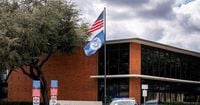Tragedy struck the Dallas Immigration and Customs Enforcement (ICE) field office on the morning of September 24, 2025, when a sniper’s bullets shattered the early calm, leaving two detainees dead, another hospitalized, and a community grappling with grief and outrage. According to CNN, the attack unfolded just after 6:40 a.m., as detainees were being transferred from vehicles into the facility—a routine moment turned deadly in an instant.
The shooter, identified by authorities as 29-year-old Joshua Jahn, opened fire from a nearby rooftop. In the chaos that followed, three detainees were struck, and Jahn himself would later die from a self-inflicted gunshot wound. The Department of Homeland Security (DHS) and ICE officials quickly confirmed the worst: Norlan Guzman-Fuentes, a 37-year-old from El Salvador, was killed at the scene. Days later, the death toll rose when Miguel Ángel García-Hernández, a 32-year-old Mexican immigrant and father of four, succumbed to his injuries after being removed from life support, as reported by the Independent and Reuters.
García-Hernández’s story, shared by his wife Stephany Gauffeny, is one of heartbreak and resilience. “His death is a senseless tragedy that has left our family shattered. I do not know how to explain to our children that their father is gone,” she told the League of United Latin American Citizens. She is now left to raise their four children—soon to be five—alone. “My husband Miguel was a good man, a loving father, and the provider for our family. We had just bought our first home together, and he worked hard every single day to make sure our children had what they needed.”
García-Hernández, a house painter who had come to the U.S. as a child, was shot four times—including once in the neck—while handcuffed in the back of a government van in the sallyport, according to The New York Times as cited by the Independent. He was critically injured in the attack and, despite medical efforts, did not survive. A GoFundMe campaign launched to support his family quickly raised more than $68,000, reflecting the outpouring of community support and the depth of the tragedy.
The sniper attack also claimed the life of Norlan Guzman-Fuentes, whose wife, Yorlen Villatoro, described him as an innocent victim caught in the crossfire. “He was caught in the crossfire of an attack he had nothing to do with,” she wrote on a fundraising page to help cover funeral expenses. Guzman-Fuentes had entered the U.S. illegally and was taken into ICE custody on September 24, the very day of the shooting, after being arrested by Dallas police on prior charges.
A third detainee, identified by media reports as Venezuelan immigrant Jose Andres Bordones-Molina, remains hospitalized as of September 30. Authorities have not released further details on his condition, but his survival is a small mercy in a week marked by loss.
Law enforcement agencies scrambled to understand Jahn’s motives. The shooter, acting alone, left behind a trove of notes at his home expressing deep animosity toward ICE and the federal government. Nancy Larson, acting U.S. Attorney for the Northern District of Texas, revealed at a press conference that Jahn’s writings made clear his intent: “Yes, it was just me and my brain,” read one note. Another chillingly stated his desire to “maximize lethality” against ICE agents. Yet, as Larson noted, “He hoped to minimize any collateral damage or injury to the detainees and any other innocent people. It seems that he did not intend to kill the detainees or harm them.”
Still, the reality proved far more tragic. The sniper fired indiscriminately into an area where detainees were being escorted, according to Reuters. No government personnel were wounded, but the physical and emotional toll on detainees and their families is immeasurable. The Department of Homeland Security labeled the incident as “an attack on ICE law enforcement,” a sentiment echoed by FBI Director Kash Patel, who posted images of shell casings from the scene—one engraved with the phrase “ANTI ICE.”
The attack comes at a time of heightened political tension and violence in the United States. Just two weeks prior, Charlie Kirk, a prominent conservative activist, was killed by a rooftop sniper during a speaking engagement in Utah. Kirk’s death, and now the Dallas shooting, have fueled concerns about a rising tide of politically motivated violence. For many, the Dallas tragedy is a grim reminder of the dangers faced by both law enforcement and those caught up in the nation’s contentious immigration system.
The backgrounds of the victims add layers of complexity to the story. García-Hernández had entered the U.S. illegally and was arrested by local police in Arlington, Texas, on August 8, 2025, charged with driving under the influence and evading arrest. ICE took him into custody on the morning of the shooting. According to DHS records cited by Reuters, he had prior convictions in 2011 and 2017 for providing false information and evading arrest. Guzman-Fuentes, too, had entered the country illegally and was arrested in late August by Dallas police on an aggravated assault charge and a warrant for driving while intoxicated. While the assault charge was dismissed, he was held by ICE due to his immigration status.
In the aftermath, Mexican President Claudia Sheinbaum addressed the tragedy at a daily press conference, affirming that Mexican officials had helped García-Hernández’s mother travel to the U.S. to be with the family. “They are in contact with the family in all respects, including financial and moral support, and, if needed, to file a legal complaint,” Sheinbaum said. The Mexican government’s intervention highlights the cross-border impact of the attack and the international attention it has garnered.
The shooter’s motivations, as gleaned from his notes, point to a deep-seated anger toward ICE, which he accused of “human trafficking.” Authorities found that Jahn had been planning the attack for months, acting entirely on his own. Despite his stated intent to avoid harming detainees, the consequences were devastating. The FBI’s investigation remains ongoing, but officials have stated there is no evidence Jahn was part of a broader conspiracy.
As the Dallas community mourns, the debate over immigration enforcement, detention practices, and the safety of both detainees and law enforcement continues to intensify. For the families of García-Hernández and Guzman-Fuentes, the pain is immediate and personal—a stark reminder of the human cost behind the headlines. The Dallas ICE shooting stands as a somber marker of a nation wrestling with its divisions, and of lives forever changed by a single morning’s violence.

